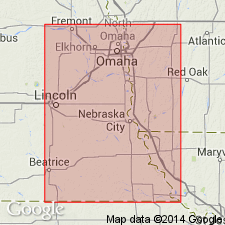
- Usage in publication:
-
- Kiewitz shale bed
- Modifications:
-
- Original reference
- Dominant lithology:
-
- Shale
- AAPG geologic province:
-
- Forest City basin
Summary:
Pg. 42, 55. Kiewitz shale bed of Howard limestone member of Shawnee formation. Howard limestone member of Shawnee formation in Nebraska consists of 2 limestones separated by a shale bed of variable thickness here named Kiewitz shale, from Kiewitz quarry, west of Meadow, southeastern Nebraska. This shale is bluish to gray, argillaceous to quite calcareous, fossiliferous, and 2 or more feet thick. The upper limestone of Howard member was named "Louisville limestone" by Condra and Bengston, from Louisville, Nebraska, and that name, although preoccupied, is in use for this unit in Nebraska. The lower limestone of Howard member is here named Church limestone. Age is Pennsylvanian (Missouri age). Report includes cross sections, measured sections, geologic maps, stratigraphic tables.
Source: US geologic names lexicon (USGS Bull. 896, p. 1093); GNC KS-NE Pennsylvanian Corr. Chart, sheet 1, Oct. 1936; supplemental information from GNU records (USGS DDS-6; Denver GNULEX).
For more information, please contact Nancy Stamm, Geologic Names Committee Secretary.
Asterisk (*) indicates published by U.S. Geological Survey authors.
"No current usage" (†) implies that a name has been abandoned or has fallen into disuse. Former usage and, if known, replacement name given in parentheses ( ).
Slash (/) indicates name conflicts with nomenclatural guidelines (CSN, 1933; ACSN, 1961, 1970; NACSN, 1983, 2005, 2021). May be explained within brackets ([ ]).

